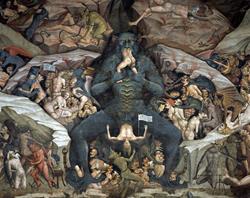Je vous pedagogize.

Painting by Jacopo Ricci[2] / Ref.: 0_5458846_125008.jpg
“ …capability to set rules, that is to establish relationships which are sanctioned according to merit. It is the capacity inherent in a primary citizenship, whose connections don’t look after a protection from the standards of the secondary citizenship, usually known as ‘State law’…”[1]
“ …When being born (zero time) a baby comes in contact with someone else, outside his own, or her, own body-thought, and immediately sanctions that offer in terms of pleasure or displeasure, the displeasure referred to a not well-being : crying does sanction displeasure and dissatisfaction, sleeping does sanction pleasure and satisfaction.
Afterwards (time one) a baby gets to distinguish an ex-citement coming to satisfaction from that one not coming to satisfaction : on his own, or her own a baby can’t satisfy any hunger, vary the light or any outside noise. Also a few organic dysmetabolisms with suffering, diabetes for example or a benign epilepsy can’t yet be diagnosed.
It is in a time-two that one, or more than one, partners can be recognized as a favourable physical presence because they allow the satisfying of a wish or ex-citement otherwise not possible. Accepting someone as a partner in one’s own principle of pleasure – it is the conjugation – and working it out in ‘satisfaction’ is then one and only goal with no coming back.
Any further experiences of pleasure / displeasure will be judged compared with the surplus of satisfaction. The sedation itself will function, from now on, as a surrogate and a substitute, then disappointing.
As a matter of fact a child can now single out his own, or her own well-being in a physical presence of the partner, or partners, arranging his own, or her own thought-body (work-one : offering one’s own thought-body to receive satisfaction is an ‘outside investment’, i.e. work) to receive satisfaction. It is already ‘work’, as it is an individual processing of an unconscious-who-can-no-longer-wait. And it is an investment, i.e. economically oriented.
In a time-three, a child gets to finish (work-two) his own, or her own, demand to the partner.
It is infact in the acknowledgement of this concluding satisfaction, in which a child has been calling, favouring and propitiating the partner to give an offer in order to achieve the goal that he, or she can experience ‘I’, as powerful toward the partner.
Getting to the words can speed up the appointment with the partner, only if that can be linked with a further surplus of satisfaction.
Any data on these four times are irreplaceable in the care of psychopathologies…”[3]
Marina Bilotta Membretti / Cernusco sul Naviglio – April 22, 2020
[1] “Il pensiero di natura”, Giacomo B. Contri SIC Edizioni 1998, p.26
[2] Independent painter in Valenza-Alessandria (Italy), Jacopo Ricci is born in Milan in ‘80s (1988). He loves painting since he was a child but does turn on coloured pencils and brushes just at his Superior degree. He nowadays cooperates with online magazines, also for on demand commissions. In 2018 he illustrated ‘Dottor Tremarella’ and ‘Guarda Oltre’ (published by the author himself). In 2019 began also working on serigraphy.
[3] “Ereditare da un bambino. Perché no ?”, Marina Bilotta Membretti 2014 ISBN 978-88-91081-63-6 Gruppo Editoriale L’Espresso SpA, ‘Un inizio in quattro tempi?’ p.28



